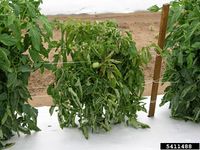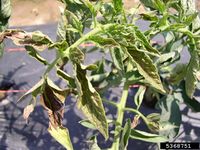Orthotospovirus tomatomaculae
| Literature database |
|---|
| 644 articles sorted by: |
| • year (descending) |
| • research topics |
| • countries/regions |
| • host plants |
| • list of antagonists |

Author: Carlos Gonzalez
Source: Wikimedia Commons
Orthotospovirus tomatomaculae
Assigned virus:
• tomato spotted wilt virus (TSWV)
The tomato spotted wilt virus has a world-wide distribution, causing a serious disease on tomatoes and various other crops. Over 800 hosts have been identified, in particular from the families of Solanaceae and Compositae. Apart from tomato, crops at risk are mainly tobacco, green pepper, groundnuts, potato and lettuce. Epidemics can cause total crop losses.
The symptoms on tomatoes include bronzing of the upper leaf surface and curling down of the leaves. Mottling and ring-spot symptoms can be also found on the fruits and the leaves. The virus is transmitted by thrips like Thrips tabaci in which the virus replicates.
The particles of TSWV are 80-120-nm long, pleomorphic, but usually spherical and have surface projections. The genome consists of three negative or ambisense ssRNAs.
Orthotospovirus tomatomaculae is the type species of the genus Orthotospovirus.
| Vernacular names | |
|---|---|
| • Deutsch: | Tomaten-Bronzeflecken-Virus |
| • English: | tomato spotted wilt virus |
| • Español: | peste negra del tomate |
| • Français: | virus de la maladie bronzée de la tomate |
The occurrence of many weed hosts that harbour the pathogen and the involvement of different thrips vector species make it difficult to control the virus. Resistant cultivars have been developed for some crops like groundnuts. Removal of infected plant debris, volunteer crops and crop rotation is also recommended.
- Other symptoms of tomato spotted wilt virus infections (IPM Images, Flickr - click to enlarge)















